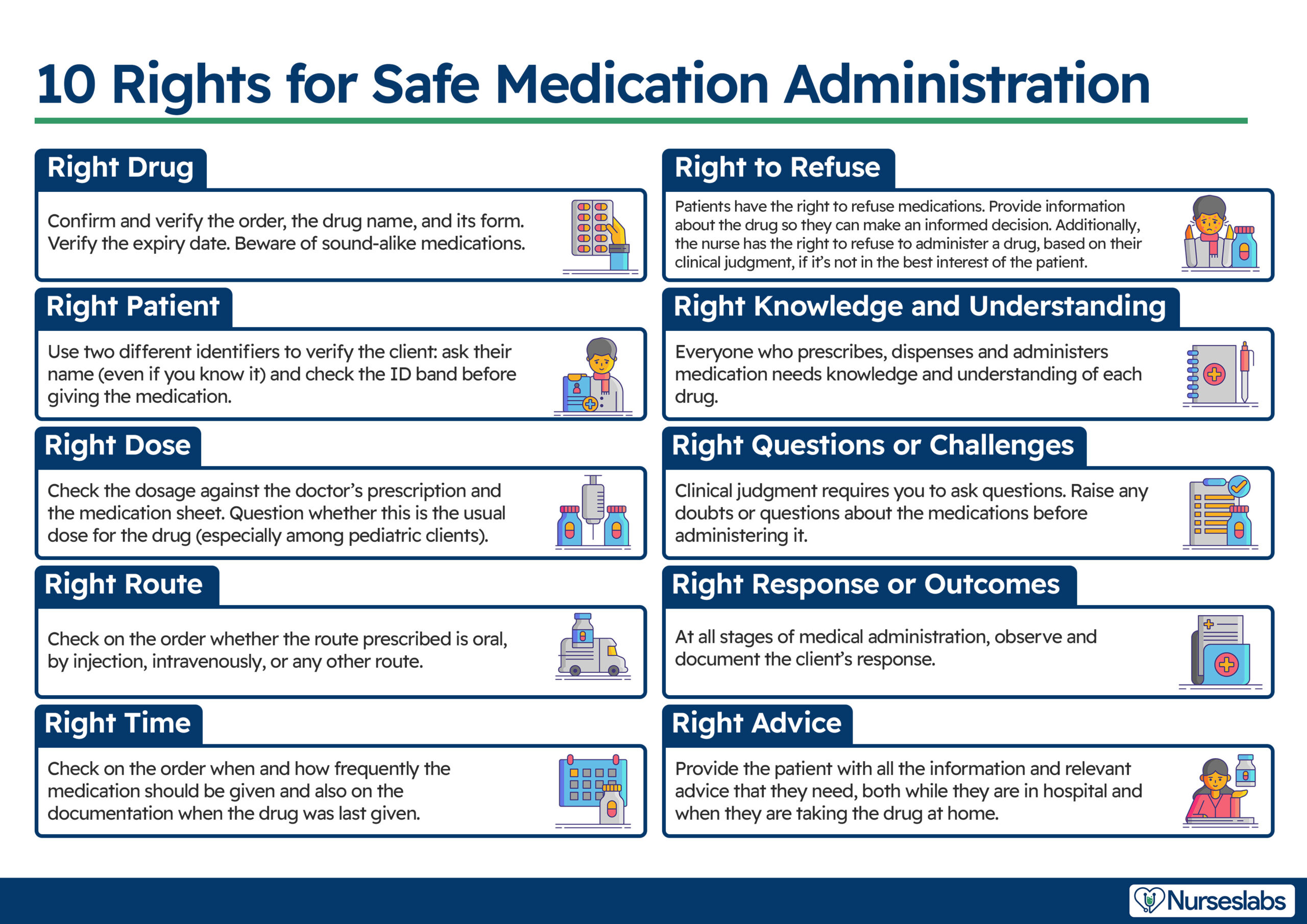Understanding the 10 Rights of Drug Administration can help prevent many medication errors. Nurses, who are primarily involved in the administration of medications, benefit from this simplified memory aid to help guide them to administer medications safely.
Nurses are responsible for ensuring safe and quality patient care at all times. As many nursing tasks involve a degree of risk, medication administration arguably carries the greatest risk. Research on medical administration errors (MAEs) showed that there is a 60% error rate mainly in the form of wrong time, rate, or dose. Some medication errors cause permanent disability and for others the errors are fatal. Follow these 10 rights of drug administration to ensure safe patient care.

1. Right Drug.
The first right of drug administration is to check and verify if it’s the right name and form. Beware of look-alike and sound-alike medication names. Misreading medication names that look similar is a common mistake. These look-alike medication names may also sound alike and can lead to errors associated with verbal prescriptions. Check out The Joint Commission’s list of look-alike/sound-alike drugs.
2. Right Patient.
Ask the name of the client and check his/her ID band before giving the medication. Even if you know that patient’s name, you still need to ask just to verify.
3. Right Dose.
Check the medication sheet and the doctor’s order before medicating. Be aware of the difference between an adult and a pediatric dose.
4. Right Route.
Check the order if it’s oral, IV, SQ, IM, etc..
5. Right Time and Frequency.
Check the order for when it would be given and when was the last time it was given.
6. Right Documentation.
Make sure to write the time and any remarks on the chart correctly.
7. Right History and Assessment.
Secure a copy of the client’s history to drug interactions and allergies.
8. Drug approach and Right to Refuse.
Give the client enough autonomy to refuse the medication after thoroughly explaining the effects.
9. Right Drug-Drug Interaction and Evaluation.
Review any medications previously given or the diet of the patient that can yield a bad interaction to the drug to be given. Check also the expiry date of the medication being given.
10. Right Education and Information.
Provide enough knowledge to the patient of what drug he/she would be taking and what are the expected therapeutic and side effects.

Your we is very important and useful
Thanks
is there any other rights of medication administration
Very impressive they are now 10
It’s very useful
Thank you Matt, this really helped me to easily remember so now I do know why are the reasons for the
10 rights.
Very educating
Very useful, thank you
does anyone use a pill identifier to make sure you are giving the right drug?
Very informative
Is the patient right to refuse the treatment they get.
Right to refuse seems more like an overall patient right, all patients always have to refuse treatment. This right does not seem to equate with the steps or process as described by the other rights. Note the term right when used as a right to refuse is a noun; right when used as a verb, describes the proper or safety in the steps used to administer.
Everyone have a right to refuse medication if they don’t think it’s for the best safety cuz they know they own self and we all got our rights according to the law and regulations thank you
Short and sweet . Very useful
The right to refuse is often commonly not seen as a right by those administering to patients; and frequently overlooked because ‘it has been prescribed’ therefore, the patient needs to take it. However, as mentioned by other commentators; a patient has the right to refuse and his/her/their decision must be respected unless they do not have the mental capacity and been assessed and documented as such.
Every resident or patient has a right to decline medication if need be I have worked in different nursing homes where some residents refused medication from a particular nurse or cater This seems a problem to the home Medication can be stored safely somewhere and labelled followed by attempts by another nurse or cater in a persuasive way and explanation If the resident refuses after that it must be recorded and report written Manger to be informed No one to be forced to take medication
Does the Medication Administration 1 hr rule apply to metformin?
Very useful and keeps us up to date. Thank you.
Very useful
Hello Almarie, Awesome, I’m glad you found it useful! If there’s any other info or topics you’re interested in, feel free to share. Always here to help!
Very useful thank you
please help me with this problem, If you’re prescribed a medication, and your Insurance deny’s it or it’s not covered, than it’s sent to be filled anyway without you being informed that it was denied , and you later find out that the cost was very high, and was taken out of your account without you being informed of the cost, and it not being covered by your insurance, should you have been informed by your doctor or care team of the cost of this medication before it was filled, so you could have had the chance to say no, do not fill it, I am not paying that amount, so i decline this medication, don’t fill it.
We need more useful information like this. Thank you
Hi Emmanuel, You’re welcome! I’m really glad to hear you found the information on the 10 rights of drug administration useful. It’s super important to spread awareness about safe medication practices. If there’s anything more specific you’re interested in or other topics you think we should cover, please let me know. Always looking to provide valuable content that can help out.
thanq sir /mam
giving information
But on *right education and information* it is saying, we are suppose to tell the patient everything about the drug, so, what if that drug has a side effect of leading to death if not taken safely, are we suppose to give this information to the patient or just skip it to avoid patient’s fear upon it?
Hi Charles,
Great question. It’s definitely important to provide patients with the right education and information about their medications, including potential side effects, even if they’re severe like the risk of death. This is part of ensuring informed consent, where patients have all the necessary information to make decisions about their treatment.
However, it’s also crucial how you communicate this information. The goal isn’t to instill fear but to inform and educate. You can explain the side effects while also emphasizing the measures taken to minimize risks, such as dosage instructions, monitoring, and what signs to watch for that require immediate attention.
Balancing honesty with reassurance is key. Patients trust us to give them the full picture so they can take an active role in their care safely and confidently.
Thanks indeed have witnessed those are the main rights
Only that refuse doesn’t work cos patients and care takers put more emphasis on medication